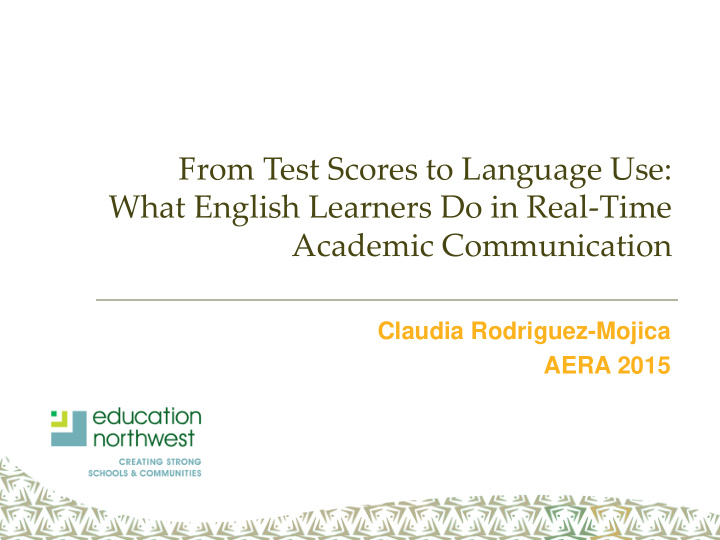



zyxwvutsrqponmlkjihgfedcbaZYXWVUTSRQPONMLKJIHGFEDCBA From Test Scores to Language Use: What English Learners Do in Real-Time Academic Communication Claudia Rodriguez-Mojica AERA 2015
zyxwvutsrqponmlkjihgfedcbaZYXWVUTSRQPONMLKJIHGFEDCBA Shift in new standards Stating basic Providing concepts and explanations and facts descriptions grounded in evidence
zyxwvutsrqponmlkjihgfedcbaZYXWVUTSRQPONMLKJIHGFEDCBA zyxwvutsrqponmlkjihgfedcbaZYXWVUTSRQPONMLKJIHGFEDCBA Misuse of terms Explanation, description and argumentation in Science (Osborne & Patterson, 2011) “Refer to details and examples in a text when explaining what the text says explicitly…” (CCSS 4.1) “Explain the meaning of the word spoil”
What does it mean to explain?
What does it mean to describe?
zyxwvutsrqponmlkjihgfedcbaZYXWVUTSRQPONMLKJIHGFEDCBA Why does this matter? • If we’re expecting young children to produce explanations and descriptions, our expectations should be clear • Misalignment between standards expecatations, teacher and student understanding can be a problem • Important to clarify for all students, but especially for emerging bilinguals
zyxwvutsrqponmlkjihgfedcbaZYXWVUTSRQPONMLKJIHGFEDCBA Explaining in English language arts Explanations provide information on a topic for which the interlocutor lacks information The case to be explained is understood as having in fact occurred and the explanation will serve to supply missing information (Faye, 2007)
Explaning & Describing in ELA Explain Describe Definition Description-giving explanation: Describe : a prompted gives an account of something or unprompted thta the interlocutor does not account of someone already know or something Definition Reason-giving explanation: Is in Describe the meaning response to an implicit or explicit of a word : hereafter “why” question for which the referred to as “define” interlocutor does not already know the answer
To w hat extent do young English learners produce explanations and descriptions in academic communication w ith the teacher during English language arts?
zyxwvutsrqponmlkjihgfedcbaZYXWVUTSRQPONMLKJIHGFEDCBA Data Sources Over a period of six months, two times a week … – Classroom observations – Audio recorded eight, grade 4 English learners • Students wore recorders and microphones • Captured focal students’ and interlocutors’ talk • 288 hours total – Analyzed 40+ hours of ELA talk – Interviews and informal conversations with focal students and classroom teacher – Student background questionnaire
zyxwvutsrqponmlkjihgfedcbaZYXWVUTSRQPONMLKJIHGFEDCBA Data Analyses • Initial identification of explanations and description from previous paper • Coded – Teacher talk – Type of questions: how, what, who, why, unspoken – Nonquestions: commands, sentence starters – Not informative
zyxwvutsrqponmlkjihgfedcbaZYXWVUTSRQPONMLKJIHGFEDCBA zyxwvutsrqponmlkjihgfedcbaZYXWVUTSRQPONMLKJIHGFEDCBA Explanations almost never occurred and were not very rich 3 attempts of description-giving explanations, all in response to sentence starters or silence: • My analysis of this fossil is that it is a green, light green block. Seven attempts of reason-giving explanations, all produced by “successful” ELs: • I think this because I see like lime green right here.
zyxwvutsrqponmlkjihgfedcbaZYXWVUTSRQPONMLKJIHGFEDCBA The teacher didn’t seem to have the tools zyxwvutsrqponmlkjihgfedcbaZYXWVUTSRQPONMLKJIHGFEDCBA to support production of Explanations Ms. Nielson Why DON’T you think that there’s a monster inside Olivia ((2 sec pause)) Olivia °Be:cau:se u:m° Ms. Nielson =Why do you think the garbage can is making all the: gurgling noises ((8 sec pause)) Ms. Nielson What do you think is going on in the garbage can What’s your prediction. I think Olivia °I th[ink°] Ms. Nielson [think] the garbage can’s gasping because Olivia °I think the garbage ca:n is gasping becau:se u:m° ((2 sec pause)) ((Clears throat)) °U:m° Ms. Nielson Complete your sentence What do you think What do you think’s going on Olivia °Maybe the:re- there’s a:° °A:°
zyxwvutsrqponmlkjihgfedcbaZYXWVUTSRQPONMLKJIHGFEDCBA Implications • As a whole, ELs rarely produced explanations – How do we increase opportunities for explanation and description production? • Supporting student talk takes more than using strategies in teachers’ toolkit • Thinking carefully about how the scaffolds we provide influence student responses
zyxwvutsrqponmlkjihgfedcbaZYXWVUTSRQPONMLKJIHGFEDCBA Questions? Claudia Rodriguez-Mojica Claudia.Rodriguez- Mojica@educationnorthwest.org
zyxwvutsrqponmlkjihgfedcbaZYXWVUTSRQPONMLKJIHGFEDCBA Extra Slides…
zyxwvutsrqponmlkjihgfedcbaZYXWVUTSRQPONMLKJIHGFEDCBA CCSS Reading Standard 4.1 Refer to details and examples in a text when explaining what the text says explicitly and when drawing inferences from a text
zyxwvutsrqponmlkjihgfedcbaZYXWVUTSRQPONMLKJIHGFEDCBA zyxwvutsrqponmlkjihgfedcbaZYXWVUTSRQPONMLKJIHGFEDCBA Descriptions occurred slightly more frequently 23 attempts to describe, produced by “successful” and “struggling” students: The next step to take is see if you could color stuff.
zyxwvutsrqponmlkjihgfedcbaZYXWVUTSRQPONMLKJIHGFEDCBA Students tended to use examples to produce definitions, but also used type of word and dictionary-like definitions 15 attempts at definitions, most from “struggling” students: • Introduced means when you go to a museum they introduce you to someone • That’s a nasty word • Vote, to choose a leader
Recommend
More recommend